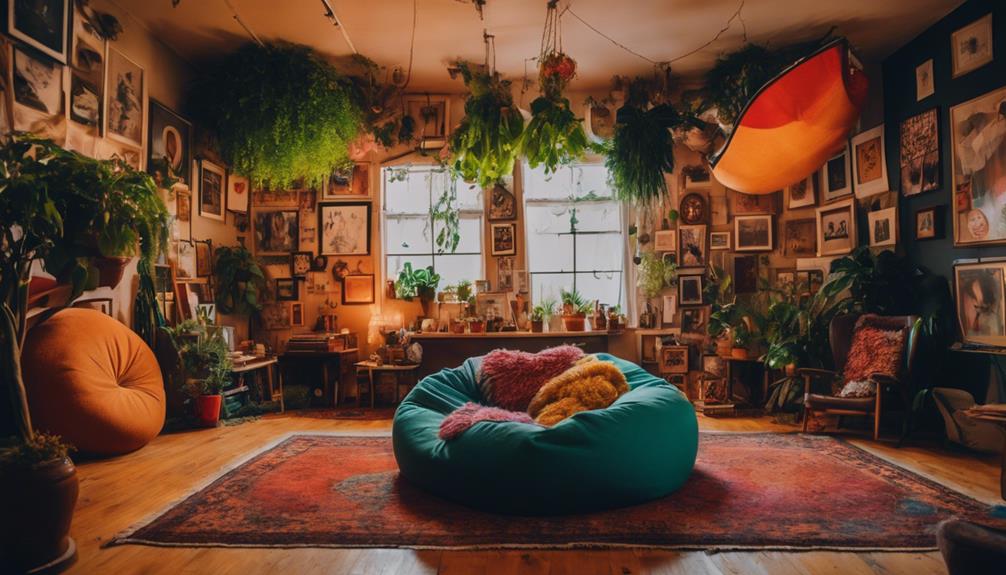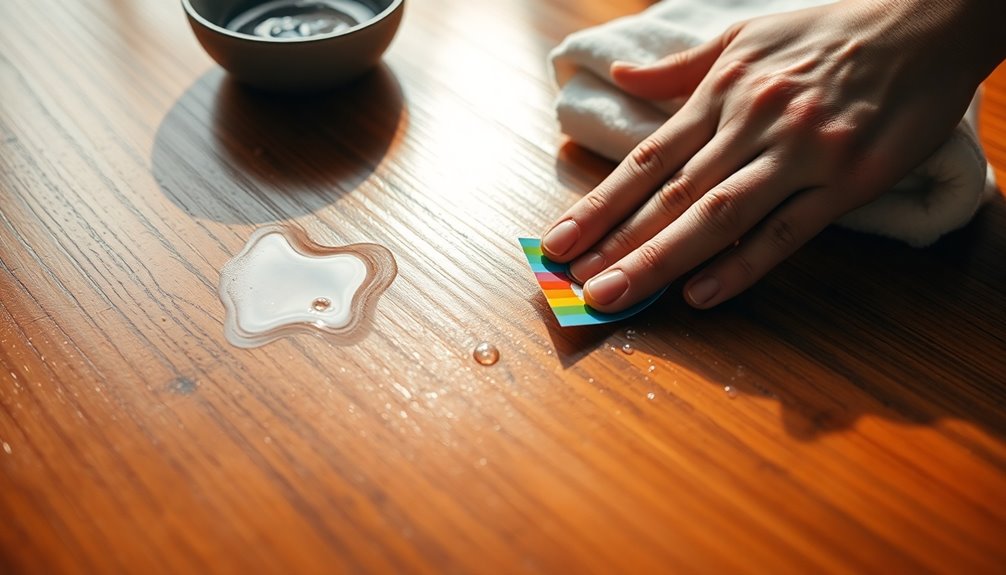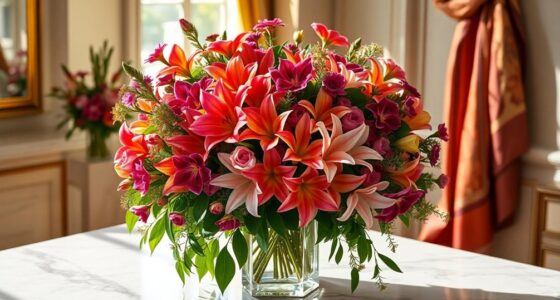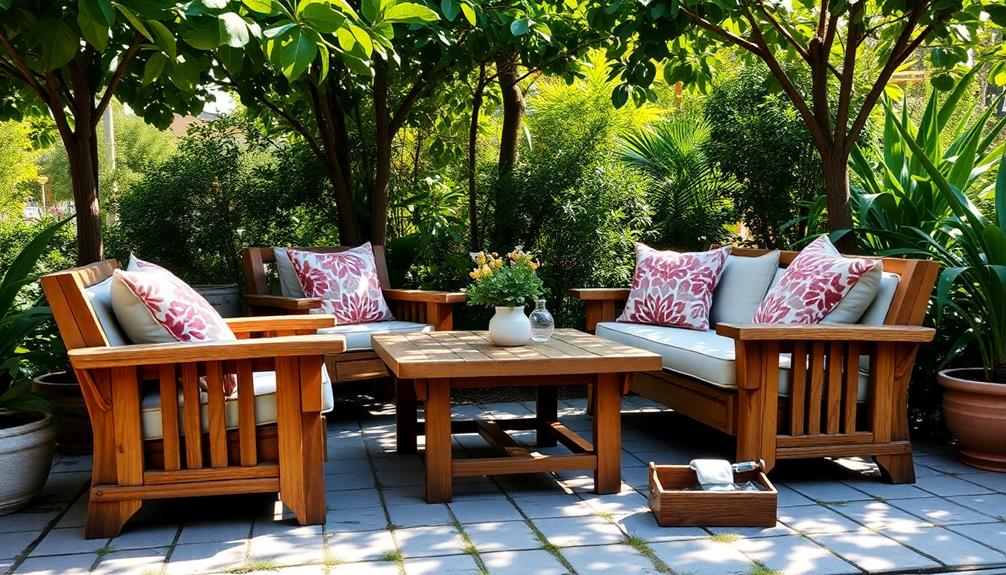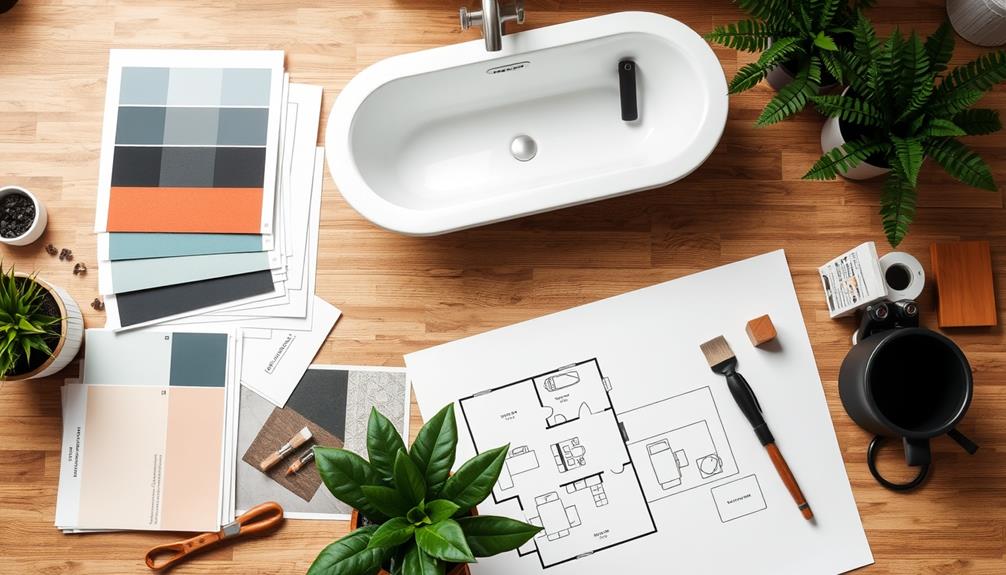Unconventional room decor allows you to break free from the ordinary and showcase your individuality. Begin with bold colors and mix warm and cool tones to create a lively atmosphere. Incorporate fun furniture, such as inflatable chairs or tree stump tables, for added functionality. Unique lighting, like kaleidoscopic lamps or glow-in-the-dark fixtures, helps set the tone and ignite conversations. Embrace whimsical art and unconventional materials like reclaimed wood to add charm. By incorporating quirky elements, your space will surprise and delight visitors. There is so much more you can explore to take your decor to the next level!
Key Elements
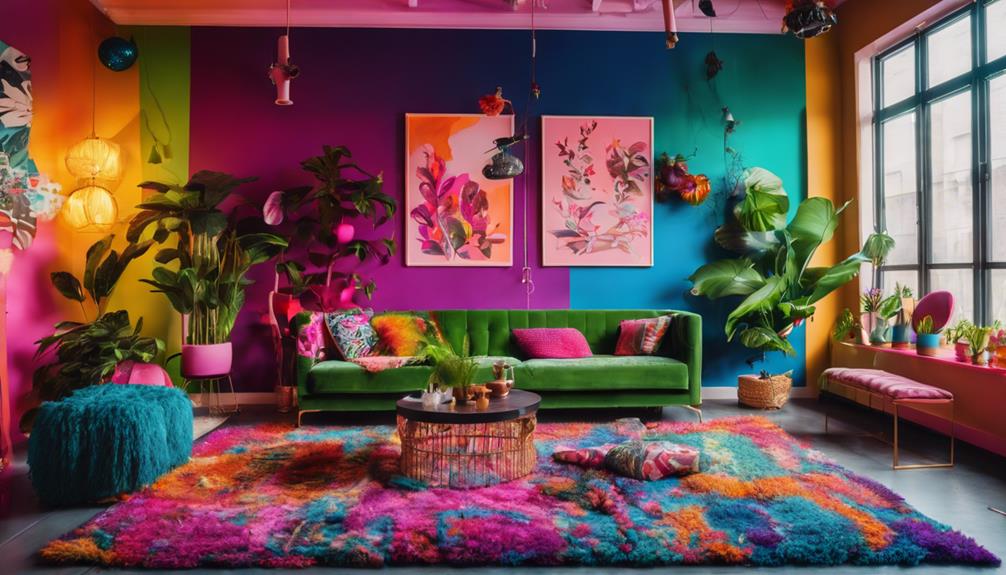
When you're designing your weird room decor, the color scheme plays an essential role in setting the mood.
Mixing materials and textures can also add depth and intrigue to your space.
Color Scheme
A vibrant color scheme can transform your room into an energetic haven, with bold choices like electric blues and fiery reds breathing life into the space. To express your unique personality, consider mixing warm and cool tones, like mustard yellow and charcoal gray, to create a balanced, visually stimulating environment. This approach adds depth and intrigue, ensuring your decor doesn't feel one-dimensional.
Monochromatic color schemes can also be a fabulous option. By utilizing varied shades of a single color, you achieve a sophisticated yet unconventional look that stands out. Don't be afraid to incorporate unexpected textures, either; they can enhance your color choices and create visual interest.
Whimsical pastels combined with classic hues deliver a playful vibe that invites creativity. These vibrant colors can highlight quirky decor elements, making your space feel truly one-of-a-kind.
You can also elevate your design with metallic accents, like gold or silver, which act as eye-catching focal points while complementing your bold color choices.
Embrace these ideas to curate a color scheme that reflects your individuality and breathes life into your living space!
Materials
Incorporating unconventional materials like reclaimed wood and metal can instantly infuse your decor with unique character and charm.
These materials not only stand out but also promote a sustainable lifestyle, making them eco-friendly choices for your home. You can create visual appeal by mixing natural elements such as stone and ceramics with plants, which adds vibrancy while grounding your space.
Consider including vintage items, like old metal tools or suitcases, as unique decor pieces. They add charm and a sense of history, making your space feel more personalized.
These items spark conversation and give your decor a story.
Textured fabrics can also play a significant role in your design. Layering different fabrics creates a rich visual experience and invites touch.
Whether you opt for soft linens or rugged burlap, these textiles enhance the comfort of your room.
Textures
Mixing diverse textures, like plush faux fur with sleek metallic surfaces, brings a tactile rhythm that enhances the sensory experience in your space. By incorporating smooth, rough, shiny, and matte textures, you create visual interest that makes your decor more dynamic and intriguing. This unique blend of elements invites exploration and interaction within the room.
Layering textiles is another effective way to elevate your decor. Consider combining patterned pillows with woven throws to add comfort and depth. This eclectic mix not only feels inviting but also showcases your creativity. Don't shy away from unexpected designs; textures like reclaimed wood or crinkled leather inject character into your space, offering a distinctive aesthetic appeal.
You can also play with wall treatments, using textured paint finishes or ceramic elements to add even more visual interest. These choices allow you to create a rich atmosphere that captivates anyone who enters.
Essential Fixtures and Furniture

When it comes to essential fixtures and furniture, you can really amp up your space with some fun pieces.
A whimsical tree stump table adds a touch of nature, while a giant inflatable unicorn chair or cactus chair brings playful vibes.
These quirky options not only serve a purpose but also make your room uniquely yours.
Whimsical Tree Stump Table
A whimsical tree stump table transforms any room into a cozy retreat, combining functionality with a touch of nature's charm. This unique piece adds a natural element that draws the eye and sparks conversation. With its detailed textures and organic shapes, each table showcases the beauty of reclaimed wood, making it a one-of-a-kind addition to your decor.
Whether you're aiming for a rustic, bohemian vibe or a modern, eclectic style, a tree stump table enhances your space's overall aesthetic. You can choose from various sizes and finishes, allowing for customization that perfectly fits your room's dimensions and design theme.
Incorporating a whimsical tree stump table not only supports sustainable practices by utilizing recycled materials but also fosters a playful atmosphere. It invites guests to gather around, share stories, and appreciate the charm of its organic form.
Giant Inflatable Unicorn Chair
The Giant Inflatable Unicorn Chair adds a whimsical flair to your space, making it an eye-catching centerpiece that encourages fun and relaxation. This statement piece not only serves as a comfortable seating option but also injects a playful touch into any room or outdoor area. Measuring about 6 feet in length, it's large enough to grab attention and spark joy among your guests.
Crafted from durable, high-quality PVC, the giant inflatable unicorn chair can support up to 300 pounds, accommodating both kids and adults. Its vibrant colors and unique unicorn design enhance your quirky decor style, turning any gathering into a lively event. Plus, it's incredibly easy to inflate and deflate, allowing for convenient storage and portability—perfect for parties, events, or casual lounging.
Whether you want to create a fun reading nook or a standout feature for your backyard bash, this whimsical chair fits the bill. Don't be surprised if it becomes the talk of the party, as it invites laughter and conversation, making every moment memorable. With the Giant Inflatable Unicorn Chair, you're not just adding furniture; you're embracing an experience.
Giant Inflatable Cactus Chair
Add a touch of whimsy to your space with the Giant Inflatable Cactus Chair, a playful seating option that's sure to be a conversation starter. This eye-catching chair features an unconventional design that resembles a cactus, making it a unique statement piece in any room. Its vibrant color adds life to your decor, whether you opt for a bohemian vibe or an eclectic mix.
Crafted from durable, high-quality PVC material, the Giant Inflatable Cactus Chair is built to withstand regular use without losing its shape or brightness. It's a versatile addition to your space, perfect for casual lounging or entertaining guests.
Plus, it's incredibly easy to inflate and deflate, allowing you to store or transport it with ease, making it ideal for events and parties.
With its fun and quirky appearance, this chair not only enhances the aesthetic appeal of your room but also creates a lively atmosphere for everyone. Embrace the unconventional and let your personality shine through with the Giant Inflatable Cactus Chair, where comfort meets creativity in the most delightful way.
Lighting Ideas
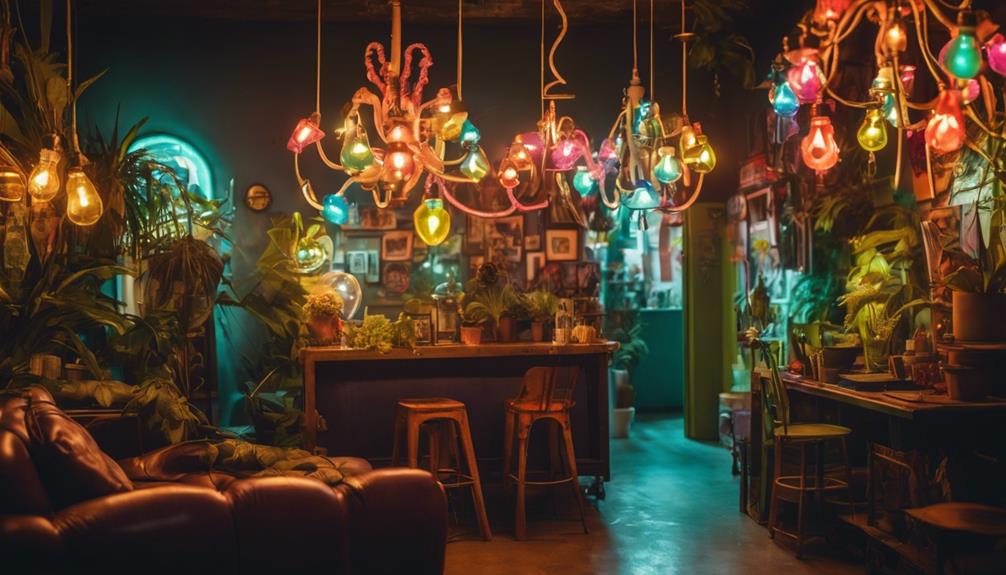
When it comes to lighting, think outside the box to truly enhance your space.
Glow-in-the-dark pendant lights, kaleidoscopic floor lamps, and color-changing bubble fixtures can all create a whimsical atmosphere that reflects your personality.
You might even consider a luminous jellyfish light fixture for an eye-catching centerpiece that sparks conversation.
Glow-In-The-Dark Pendant Lights
Glow-in-the-dark pendant lights bring a playful charm to your space, illuminating it with a soft glow that transforms the atmosphere at night. These whimsical fixtures not only provide essential lighting but also create a unique focal point in any room. You'll find them in various shapes and styles, making it easy to integrate them into your chosen design theme, whether it's retro, modern, or eclectic.
One of the standout features of glow-in-the-dark pendant lights is their ability to spark conversation. Imagine your guests marveling at how the lights absorb daylight and emit a gentle glow after dark. They're perfect for bedrooms, game rooms, or creative studios, where you want to inspire a fun, inviting environment.
In addition to their aesthetic appeal, many glow-in-the-dark pendant lights are energy-efficient, utilizing LED technology. This not only helps reduce your electricity costs but also minimizes your environmental impact.
Kaleidoscopic Floor Lamp
A kaleidoscopic floor lamp instantly brightens your space, refracting light into a mesmerizing array of colors that captivates the eye. With its unique design, this lamp adds a touch of whimsy to your decor, making it an excellent choice for eclectic or modern interiors. The vibrant colors it produces create an inviting atmosphere that can transform any room into a lively setting.
What's great about a kaleidoscopic floor lamp is its customizable lighting. You can easily adjust the brightness to match your mood or occasion, ensuring that your space feels just right. Whether you're hosting a party or enjoying a quiet evening at home, this lamp adapts to your needs.
Moreover, many models are energy-efficient, utilizing LED bulbs that last for thousands of hours while minimizing electricity consumption. This means you can enjoy the beauty of your lamp without worrying about energy costs.
As a striking focal point, the kaleidoscopic floor lamp not only illuminates your space but also sparks conversation and admiration from guests. Embrace this whimsical decor element and watch your room come alive!
Color-Changing Bubble Light Fixture
If you loved the vibrant ambiance of the kaleidoscopic floor lamp, you'll appreciate the dynamic charm of a color-changing bubble light fixture, which offers a playful twist on illumination. These fixtures are perfect for adding a whimsical touch to any room, seamlessly blending with modern aesthetics while providing customizable ambiance.
With their ability to shift between various hues, color-changing bubble lights create an inviting atmosphere that's ideal for social spaces. Whether you're hosting a gathering or enjoying a quiet evening, the dynamic lighting can enhance moods and stimulate conversation.
Many of these fixtures use energy-efficient LED technology, ensuring a longer lifespan and making them a sustainable choice for your decor.
What's even better is that many come equipped with remote controls or smartphone apps, allowing you to adjust brightness and color settings from anywhere in the room. You can easily transform the vibe to fit your mood or occasion, making every moment special.
Luminous Jellyfish Light Fixture
Transforming your space into an underwater wonderland, the Luminous Jellyfish Light Fixture captivates with its unique design that mimics the graceful movements of jellyfish. This eye-catching piece serves as a stunning focal point, drawing attention and sparking conversation. You can easily incorporate it into your home, whether your style leans toward whimsical decor or modern elegance.
With adjustable brightness settings, you can create the perfect ambiance for any occasion. The soft, diffused light emitted by the fixture enhances the soothing atmosphere, making it an ideal addition to bedrooms, living rooms, or creative spaces. The luminous jellyfish light fixture not only adds charm but also promotes relaxation, perfect for unwinding after a long day.
Additionally, this fixture typically utilizes energy-efficient LED bulbs, ensuring a long lifespan and lower energy consumption. So, you can enjoy its beauty while being eco-conscious. Available in various colors and sizes, the luminous jellyfish light fixture allows you to customize your decor while embracing the unconventional.
Embrace this unique lighting solution and let it transform your space into a mesmerizing aquatic haven!
Decorative Elements
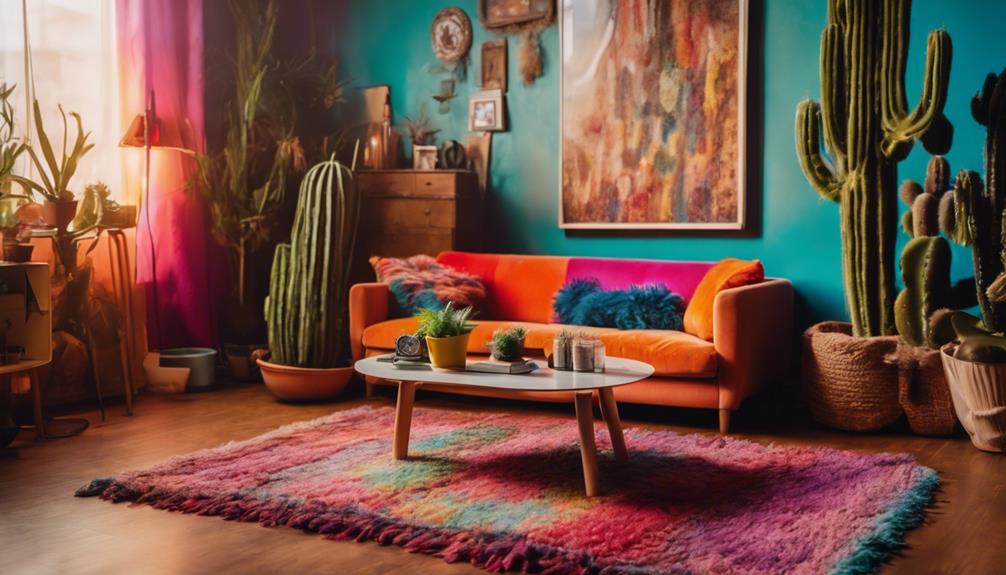
When it comes to decorative elements, think outside the box to truly elevate your space.
Whimsical taxidermy wall art and a colorful vintage record wall clock can bring a fun, unexpected vibe, while a surrealist art sculpture centerpiece adds an intriguing focal point.
These unique pieces not only enhance your decor but also spark conversations and reflect your personality.
Whimsical Taxidermy Wall Art
Embracing whimsical taxidermy wall art can instantly elevate your space, adding a playful touch that defies conventional decor norms. These unique pieces often feature quirky arrangements of animals or even mythical creatures, challenging traditional aesthetics and inviting curiosity.
They serve as fantastic conversation starters, sparking interest among guests as they ponder the stories behind each artwork.
Sourcing whimsical taxidermy from artisan shops or custom creators allows for personalization, meaning you can select pieces that truly reflect your style and taste. Many of these artworks are adorned with vibrant colors and artistic flair, making them perfect for eclectic or modern decor themes.
This lively approach to taxidermy not only beautifies your home but also promotes environmental consciousness. By showcasing the beauty of wildlife, you encourage an appreciation for nature in a creative format.
In a world where decor often feels predictable, whimsical taxidermy wall art invites you to embrace the unconventional. So, why not add a touch of the extraordinary to your walls and let your decor tell a story that's uniquely yours?
Colorful Vintage Record Wall Clock
A colorful vintage record wall clock adds a playful retro vibe to your space while keeping you on schedule. This unique decor piece combines the charm of nostalgia with functional art, making it a conversation starter.
With vibrant designs often featuring actual vinyl records, these clocks showcase your love for music and bring a sense of personality to your room.
The bold colors in a vintage record wall clock can greatly enhance the mood of your space, creating an energetic atmosphere that invites admiration.
You'll find various styles available, allowing you to personalize your decor and create an eclectic mix that complements your quirky theme.
Whether you're a devoted music lover or simply appreciate the aesthetic of vintage decor, this wall clock is a perfect addition.
Surrealist Art Sculpture Centerpiece
Surrealist art sculpture centerpieces captivate attention with their imaginative shapes and unexpected materials, making them a bold statement piece in any room. These sculptures serve as a striking focal point, challenging reality with their unconventional designs.
You'll find yourself drawn in by the visual intrigue they create, as they often incorporate unexpected materials like metal, glass, and mixed media, offering a tactile experience that enhances your decor.
Surrealist sculptures typically feature dreamlike themes, including distorted forms and whimsical characters, inviting you to explore their meanings and engage in conversation.
When you place one on a pedestal or in a well-lit area, it can dramatically transform the atmosphere of your space, adding an element of surprise and creativity.
Not only does incorporating a surrealist sculpture into your decor reflect your personal style, but it also encourages exploration of artistic expression.
Flooring

When it comes to flooring, you can really make a statement with funky painted concrete or brightly colored mosaic tiles that grab attention.
Adding a shaggy faux fur area rug can bring in a cozy texture and contrast beautifully with harder surfaces.
These choices not only enhance your decor but also reflect your unique style.
Funky Painted Concrete Flooring
Funky painted concrete flooring consistently transforms ordinary spaces into vibrant showcases of creativity through bold colors and unique designs. This flooring option allows you to express your creativity by using various patterns and techniques, like stenciling or color washing. You can turn a basic concrete surface into a statement piece that reflects your personal style.
By choosing high-quality concrete paint, you guarantee longevity and durability, making it perfect for high-traffic areas while maintaining its unique aesthetic. The visual appeal of funky painted concrete flooring can be enhanced by pairing it with different textures, such as rugs or decorative mats, providing both comfort and style.
Not only is this option cost-effective, repurposing existing concrete surfaces saves you money, but it's also eco-friendly. Using this approach reduces the need for new materials, making it a sustainable choice for modern homes.
Shaggy Faux Fur Area Rug
A shaggy faux fur area rug instantly elevates the comfort and style of any room, making it a perfect choice for those seeking a cozy atmosphere. This unique blend of plush fibers creates a cozy texture that not only feels great underfoot but also enhances comfort in your living spaces.
Available in various colors and sizes, you can find a shaggy faux fur rug that serves as a bold statement piece or a subtle accent, fitting seamlessly with your decor. These rugs are visually appealing and contribute to inviting atmospheres, making them an excellent choice for areas where you entertain guests or unwind after a long day.
Plus, they're practical for high-traffic areas, as many faux fur rugs are easy to clean—some are even machine washable. Beyond their aesthetic and practical benefits, shaggy faux fur rugs help absorb sound, reducing echoes in larger spaces while adding warmth to your home.
Whether you place it in the living room or bedroom, a shaggy faux fur area rug will transform your space into a cozy haven that surprises everyone who steps inside.
Brightly Colored Mosaic Tiles
Brightly colored mosaic tiles instantly breathe life into any room, creating vibrant patterns that draw the eye and spark conversation. With their vibrant color palette, these tiles can transform a room into a dynamic space filled with energy.
Whether you opt for intricate designs or bold geometric shapes, the patterns and textures offered by mosaic tiles allow you to create visual interest that reflects your personal style. These tiles not only make a statement but also bring a unique blend of history to your decor.
Made from durable materials like ceramic or glass, they're designed to withstand high traffic while maintaining their beauty. Their clean lines can complement modern aesthetics, making them versatile for various design themes.
Mosaic tiles enhance the perception of space, making smaller rooms feel larger and more inviting. Plus, they're relatively easy to clean and maintain, combining practicality with style.
How Can I Incorporate Dark Academia Aesthetic Into Unconventional Room Decor?
Looking to infuse your space with a touch of sophistication and vintage charm? Consider incorporating dark academia room ideas into your unconventional decor. Add elements like vintage books, antique furniture, brass accents, and rich, moody colors to create a space that feels both intellectual and unique.
Conclusion
Embracing weird room decor lets your personality shine through in unexpected ways.
By mixing key elements, unique fixtures, and striking lighting, you create an environment that's truly your own.
Don't shy away from bold decorative elements or unconventional flooring; these choices can transform a mundane space into a stunning showcase of creativity.
So go ahead, surprise everyone with your aesthetic flair, and let your room tell a story that's distinctly you!
